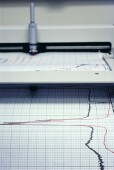
SUNDAY, Nov. 13 (HealthDay News) — Patients who develop atrial fibrillation — a heart rhythm disorder — for the first time while they are hospitalized with severe sepsis are at increased risk for stroke and death, a new study finds.
Atrial fibrillation (AF) is one of the most common heart rhythm problems among critically ill patients, according to background study information. Six percent to 20 percent of patients with severe sepsis develop new-onset atrial fibrillation, which suggests that severe sepsis may contribute to the condition, the researchers wrote.
Their analysis of 2007 data from California hospitals showed that patients with severe sepsis accounted for 14 percent of all new-onset atrial fibrillation that occurred in hospitalized patients. The researchers also found that patients with severe sepsis were nearly seven times more likely to develop new-onset AF than those without severe sepsis.
Factors associated with increased risk of new-onset atrial fibrillation in patients with severe sepsis included; being older, white and male; a history of heart failure, obesity, cancer and stroke; and organ failures, respiratory failure and renal failure.
Developing the faulty heart rhythm increased the risk of ischemic stroke (reduced blood flow to the brain) and death among patients hospitalized with severe sepsis. In-hospital ischemic stroke occurred in 75 of 2,896 (2.6 percent) with new-onset atrial fibrillation, compared with 57 of 9,986 (0.57 percent) with preexisting AF and 249 of 36,200 (0.69 percent) without AF.
In-hospital death occurred in 56 percent (1,629) of severe sepsis patients with new-onset atrial fibrillation and 39 percent (18, 027) of those without it.
The researchers said a number of factors might explain the increased stroke risk in this group of patients with severe sepsis.
“Severe sepsis alone may be associated with an increased risk of stroke through hemodynamic [blood circulation] collapse, increased systemic inflammation, and coagulopathy [clotting/bleeding disorder]. New-onset AF may simply be a marker for greater severity of illness and, thus, greater stroke risk,” wrote Dr. Allan J. Walkey, of the Boston University School of Medicine, and colleagues.
The study appears online Nov. 13 in the Journal of the American Medical Association and will be presented at the American Heart Association annual meeting in Orlando, Fla.
“Given projected estimates of severe sepsis incidence in 1 million Americans in 2011, it is likely that new-onset AF occurs in more than 60,000 patients with severe sepsis in the United States each year,” the researchers wrote.
“Current guidelines do not address AF that occurs in the setting of severe sepsis or acute infection, suggesting that new-onset AF that occurs during severe sepsis is an underrecognized public health problem. If our findings of increased stroke and death in the setting of AF and severe sepsis are replicated in other data sets, then it will be important to examine management strategies that might diminish the risk of adverse outcomes associated with AF during severe sepsis.”
More information
The U.S. National Heart, Lung, and Blood Institute has more about atrial fibrillation.

